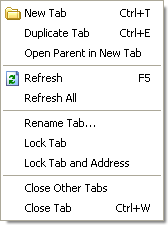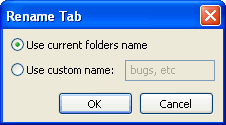Tab bar
The Tab bar displays tabs which are currently available for use; each tab is essentially a separate Files pane, viewing a specific location.

The user may quickly switch from location to location simply by selecting the appropriate tab.
Each tab has a (right-click) context menu.
Viewing tabs
If more tabs are open than will fit on the tab bar (depending on current sizing of Explorer++’s window and other panes), a set of scrolling buttons are available, allowing you to scroll left or right to view/select other tabs which are currently not visible.
Tip
The Tab bar may be extended to the full window width using an option.
Note
Hovering the mouse over a tab displays it’s true location, regardless of the tab’s title. Tab’s opened at virtual folders show their CLSID (class ID), Windows’ internal representation of their location. Practically, these CLSIDs are of no use, except to a programmer.
Opening new tabs
A new tab may be opened using a variety of methods, as listed here. From the Tab bar, the easiest methods may be
double-clicking empty space on the bar. This opens a file displaying the default contents.
using the tabs context menu
Closing tabs

When hovering the mouse over the “X” on the right side of the Tab bar, it becomes a “Close” button which will close the current tab. Tabs may also be closed by double-clicking on a tab, subject to an options setting. Other methods of closing a tab are:
from the File menu
from the tab’s context menu. The tab need not be the current (ie. selected) tab.
Tip
Be careful closing tabs - the current tab may not be visible! A tab closed in error must be re-opened and re-configured, as necessary.
Re-arranging tabs
Tabs may re re-arranged using drag-and-drop, that is
click on a tab and hold the left mouse button down
move the cursor to the new (desired) position on the Tab bar
release the left mouse button
Moving files and folders
Files and folders in a tab’s file view (ie. the Files pane) may be moved from one folder to another simply by dragging and dropping them onto a tab. If you pause slightly before dropping the items onto the tab, that tab will become active, but this is not necessary in order to complete the move.


